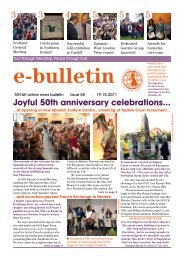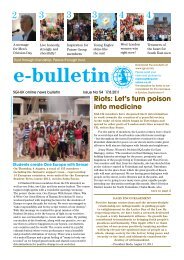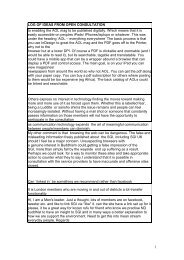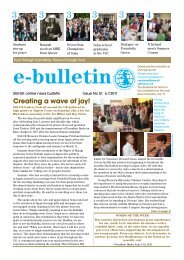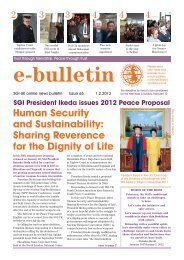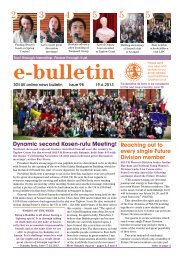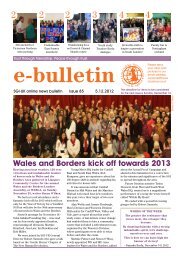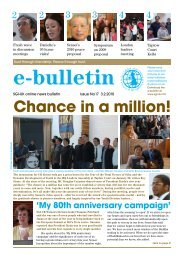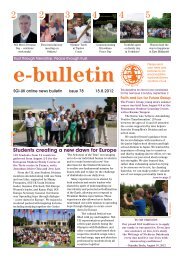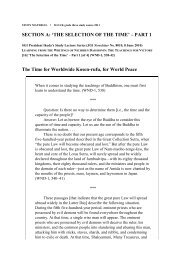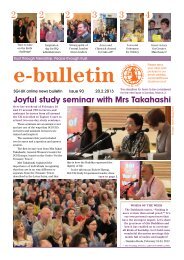The Gohonzon.pdf
The Gohonzon.pdf
The Gohonzon.pdf
Create successful ePaper yourself
Turn your PDF publications into a flip-book with our unique Google optimized e-Paper software.
TOPIC OPIC 6 THE<br />
GOHONZON GOHONZON<br />
What is the<br />
<strong>Gohonzon</strong>?<br />
<strong>The</strong> <strong>Gohonzon</strong> is the prime<br />
point of faith, practice and study in<br />
Nichiren Buddhism. It provides us<br />
with a correct model or standard of<br />
faith and practice for our time. It<br />
usually takes the form of a paper<br />
scroll, with Chinese and Sanskrit<br />
characters printed on it in black ink. It<br />
is kept in a protective box, or<br />
butsudan. <strong>The</strong> area around the<br />
<strong>Gohonzon</strong> often has offerings of light<br />
(in the form of candles), evergreen,<br />
incense, water, and fruit. You may also<br />
see other offerings, and items like a<br />
bell around the butsudan.<br />
In Reply to Kyo’o the<br />
Daishonin writes, ‘I, Nichiren, have<br />
inscribed my life in sumi ink, so<br />
believe in the <strong>Gohonzon</strong> with your<br />
whole heart.’ Although the <strong>Gohonzon</strong><br />
takes the form of a paper scroll, it is<br />
vital that when we are chanting to it, it<br />
is not seen as outside one’s life. It is<br />
through our chanting to the ‘external’<br />
<strong>Gohonzon</strong> in the butsudan, that we<br />
activate all the forces and functions<br />
within our own lives.<br />
Nichiren Daishonin began to<br />
inscribe the <strong>Gohonzon</strong> for his<br />
followers around the time of his exile<br />
to Sado in 1271. He wanted to<br />
establish an object of fundamental<br />
respect which would enable anyone<br />
chanting to it to awaken the<br />
Buddhahood in their lives, and to<br />
experience the same life state as he<br />
did. Nichiren Daishonin provided us<br />
with the means to draw out the state of<br />
Buddhahood inherent in life.<br />
<strong>The</strong> word ‘<strong>Gohonzon</strong>’ is<br />
translated into English as ‘object of<br />
fundamental respect’. ‘Go’ is an<br />
honorific prefix, and ‘honzon’ means<br />
what it is that we base our lives on.<br />
Nichiren Daishonin was<br />
aware of the difficulty people had in<br />
believing that the life state of the<br />
Buddha could exist in their lives, and<br />
then how hard it is to manifest it. His<br />
writing <strong>The</strong> Object of Devotion for<br />
Observing the Mind [WND p354] is in<br />
the form of a dialogue which strives to<br />
persuade the listener that if all the<br />
other nine worlds can be perceived in<br />
one’s life, then Buddhahood must be<br />
too. He inscribed the <strong>Gohonzon</strong> for<br />
individuals so that they would have a<br />
constant reminder of the eternal law,<br />
the cause for this life state, and which<br />
would serve as a focus for their daily<br />
practice, as well as functioning as the<br />
external cause for drawing out<br />
Buddhahood and revealing their<br />
greater self.<br />
It is not necessary to be able<br />
to read or understand the characters on<br />
the <strong>Gohonzon</strong> in order to experience<br />
benefit from chanting to it. <strong>The</strong><br />
Daishonin used script or calligraphy<br />
for the <strong>Gohonzon</strong> because he wanted<br />
the <strong>Gohonzon</strong> to be a universal mirror,<br />
free of the connotations of race and<br />
gender inherent in pictures or images.<br />
<strong>The</strong> Calligraphy on<br />
the <strong>Gohonzon</strong><br />
<strong>The</strong> <strong>Gohonzon</strong> is sometimes<br />
described as a ‘mandala’, a word used<br />
in the East to describe an object in<br />
which Buddhas and bodhisattvas are<br />
depicted or on which a philosophical<br />
doctrine is expressed. Originally it<br />
meant a circle drawn in the earth<br />
around the place where a religious<br />
ceremony was to take place. <strong>The</strong> circle<br />
embraced all the people who<br />
participated in the ceremony, and was<br />
believed to protect them from negative<br />
influences. <strong>The</strong> word mandala was<br />
rendered in Chinese as ‘perfectly<br />
endowed’ or ‘cluster of blessings’.<br />
Using Chinese calligraphy,<br />
Nichiren Daishonin put the characters<br />
Nam-myoho-renge-kyo Nichiren<br />
boldly down the centre of the<br />
<strong>Gohonzon</strong>. This represents the oneness<br />
of the Person and the Law. In other<br />
words, the ordinary person is the<br />
SGI-UK Study Department<br />
Introductory Study Programme<br />
Buddha, and the Mystic Law is<br />
inherent in each living being. He then<br />
surrounded these characters with the<br />
names of people referred to in the<br />
Lotus Sutra, such as Shakyamuni<br />
Buddha and Many Treasures and<br />
others. All the characters represent an<br />
aspect of life, whether as a protective<br />
function, or as a representative of the<br />
ten worlds, and all are illuminated by<br />
the Law of Nam-myoho-renge-kyo.<br />
In the writing <strong>The</strong> Real<br />
Aspect of the <strong>Gohonzon</strong> Nichiren<br />
Daishonin explains why he placed the<br />
particular characters where he did. <strong>The</strong><br />
blueprint for the <strong>Gohonzon</strong> was the<br />
description in the Lotus Sutra of the<br />
Ceremony in the Air, when a great<br />
jewelled Treasure Tower emerged out<br />
of the earth, and many Buddhas and<br />
bodhisattvas gathered to hear the<br />
Buddha Taho (or Many Treasures)<br />
confirm the truth that Shakyamuni had<br />
taught – that we all have the potential<br />
to reveal our Buddha nature in our<br />
daily life, as we are. This story in the<br />
Lotus Sutra represented the emergence<br />
of the state of Buddhahood in<br />
countless peoples’ lives, called<br />
Bodhisattvas of the Earth (the people<br />
who promised to propagate Nammyoho-renge-kyo<br />
at the time we now<br />
live).<br />
Shakyamuni described the<br />
dramatic events of the Tower<br />
emerging from out of the ground and<br />
reaching high into the sky. It was<br />
encrusted with precious gems and was<br />
intended to represent life with all its<br />
mystic and wonderful qualities. As it<br />
halted, floating in the air, the doors of<br />
the Tower opened and the Buddha<br />
Many Treasures was seen sitting<br />
inside. This Buddha invited<br />
Shakyamuni to enter and sit in the<br />
place of honour on Many Treasures’s<br />
right hand side. As we look at the<br />
<strong>Gohonzon</strong>, then, it is as if Shakyamuni<br />
and Many Treasures are in the Tower<br />
looking out at us and all the other<br />
characters on the <strong>Gohonzon</strong>. <strong>The</strong>n the
Buddhas lifted the tower and the<br />
assembled company into the air, in<br />
what is known as the Ceremony in the<br />
Air, an event not limited to any<br />
particular time or place. When we look<br />
at the <strong>Gohonzon</strong> in this way, we<br />
realize that we are among the<br />
Bodhisattvas of the Earth. Through<br />
chanting to the <strong>Gohonzon</strong>, we are<br />
participating in the Ceremony in the<br />
Air, just as described in the Lotus<br />
Sutra.<br />
<strong>The</strong> <strong>Gohonzon</strong> is said to<br />
contain all aspects of life, so it<br />
includes not just the positive and value<br />
creating qualities of life represented by<br />
the Buddha’s good disciples, but also<br />
examples of evil and destruction. For<br />
instance the representative of<br />
fundamental darkness, the Devil King<br />
of the Sixth Heaven is also included<br />
on it, although he too is bathed in the<br />
transforming power of Nam-myohorenge-kyo<br />
and revealing his<br />
enlightened rather than his negative<br />
aspects.<br />
<strong>The</strong> four corners of the<br />
<strong>Gohonzon</strong> each contain a Heavenly<br />
King, a character that represents the<br />
protective forces of the universe.<br />
Between these, in the middle of each<br />
side, and written in Sanskrit<br />
calligraphy are the characters Aizen<br />
(or Craving Filled) on the left as we<br />
look at the <strong>Gohonzon</strong> and Fudo (or<br />
Immovable) on the right, who<br />
represent the principles that `earthly<br />
desires are enlightenment` and `the<br />
sufferings of birth and death are<br />
nirvana`, respectively. Nichiren<br />
Daishonin’s teachings enable us to<br />
transform our desires and our<br />
sufferings into enlightenment, rather<br />
than having to deny them.<br />
Practising with the<br />
<strong>Gohonzon</strong><br />
Nichiren Daishonin teaches<br />
that the <strong>Gohonzon</strong> enables us to see<br />
the ten worlds in our lives, in other<br />
words, that we have Buddhahood, and<br />
can use it. It is easy to see the lower<br />
life states, and to have the illusion that<br />
we can never be like the Buddha. <strong>The</strong><br />
<strong>Gohonzon</strong> is described as a clear<br />
mirror which shows the law of Nam-<br />
myoho-renge-kyo and all its<br />
manifestations in the different life<br />
states, revealing their enlightened<br />
qualities.<br />
<strong>The</strong> way to practise is to have<br />
the attitude while we are chanting that<br />
we are in no way different or separate<br />
from the eternal Law of Nam-myohorenge-kyo,<br />
or the Buddhas who are<br />
enlightened to that Law. <strong>The</strong> key is to<br />
praise one’s inherent Buddhahood and<br />
then go out into the world and practise<br />
as a bodhisattva, treasuring others,<br />
encouraging them to experience their<br />
Buddhahood too.<br />
Through studying Nichiren<br />
Daishonin’s writings and awakening<br />
the wisdom we have within our lives,<br />
we become alive with the qualities of<br />
the Buddha state that are embodied in<br />
the <strong>Gohonzon</strong>. At the same time, we<br />
develop a natural desire to change our<br />
lives so that we bring out more and<br />
more consistently the condition of<br />
Buddha revealed by the <strong>Gohonzon</strong>.<br />
<strong>The</strong> more we practise with this desire<br />
to change, the more our lives and<br />
Nichiren Daishonin’s life-state<br />
embodied in the <strong>Gohonzon</strong> become as<br />
one.<br />
This is a gradual process.<br />
When we practise to the <strong>Gohonzon</strong>,<br />
Nichiren Daishonin said we are<br />
simultaneously in the state of<br />
Buddhahood or enlightenment, but we<br />
cannot easily discern that life<br />
condition with our minds; therefore we<br />
do not always act accordingly.<br />
However, through our constant<br />
relationship with the <strong>Gohonzon</strong>, we<br />
gradually challenge and overcome the<br />
influence of negativity arising from<br />
our karma. As we open up our hearts<br />
we can begin to experience all those<br />
qualities of Buddhahood working<br />
naturally and vibrantly inside us and<br />
affecting everything that we think and<br />
say and do.<br />
President Ikeda has recently<br />
described the process as this: ‘When<br />
we chant Nam-myoho-renge-kyo while<br />
practising for ourselves and others,<br />
with the <strong>Gohonzon</strong> of Nam-myohorenge-kyo<br />
manifested by the Buddha<br />
as our clear mirror, and with deep<br />
confidence in the <strong>Gohonzon</strong> existing<br />
in our own lives, Myoho-renge-kyo<br />
within us resonates with the Myoho-<br />
renge-kyo outside us, and the world of<br />
Buddhahood emerges within us.’<br />
[World of Nichiren Daishonin’s<br />
Writings Part 12].<br />
Introductory study<br />
programme materials<br />
Version 2.0 for use from<br />
July 2004<br />
SGI-UK, Study Department, Taplow<br />
Court, Taplow, SL6 0ER, UK



